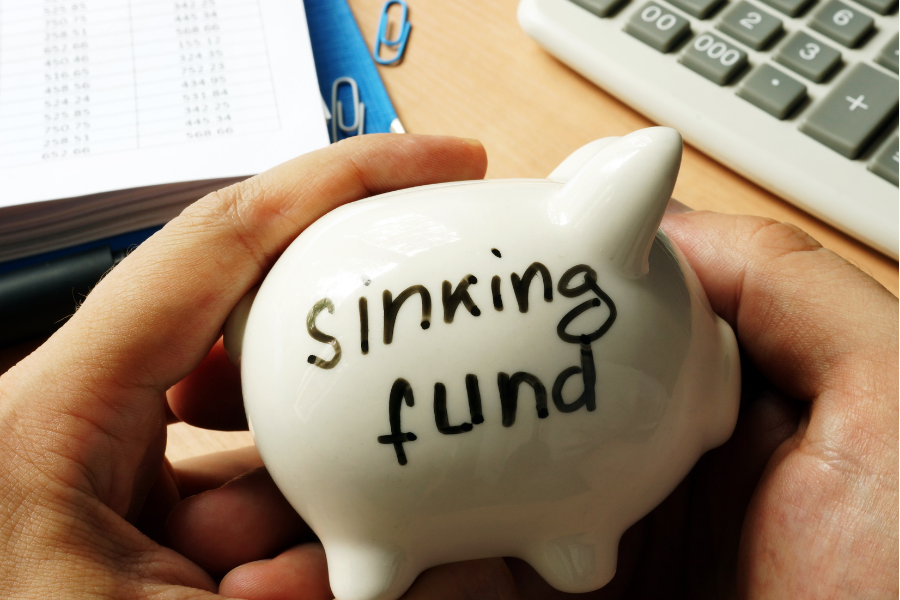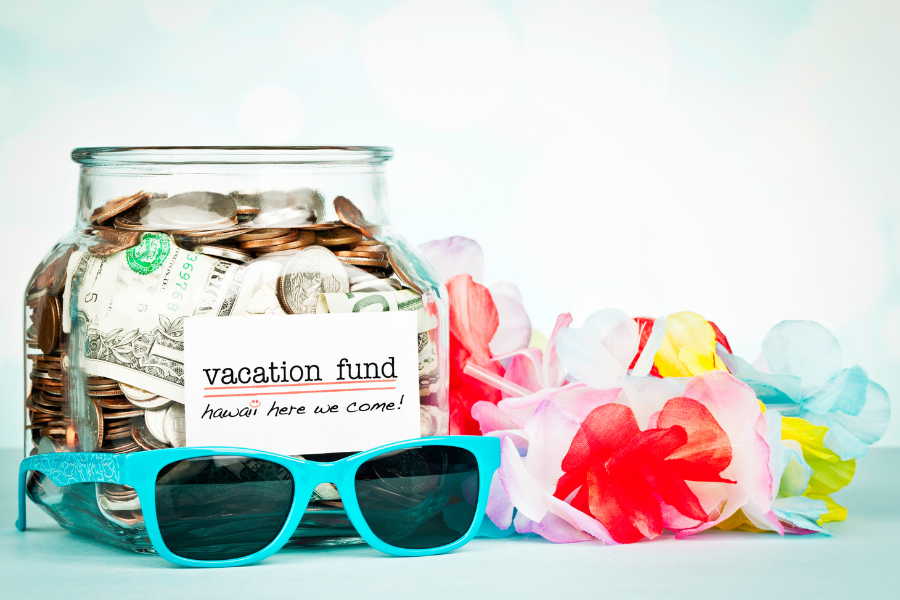What Is a Sinking Fund?

A sinking fund is when you set aside a little bit of money at a time to save for a larger purchase in the future. It can be used for anything from an annual car insurance bill, birthdays, vacations and so much more. I personally have sinking funds for several different categories including;
- Occasions – I use this fund for Holidays, Birthdays and weddings. This helps me have control over my budget when it’s time to spend on some gifts.
- Vacations – I love traveling and it is very important to me. Each check I have money set aside specifically for vacations.
- Car insurance/repairs – Being suddenly hit with a $900 insurance bill or $800 for new tires is tough on a tight budget. That’s why I set aside money every two weeks for my car
- Home repairs – Things like a broken dryer or busted storm door can set you back if you cannot afford the repairs (yes these both happened to me). I save about 1% of my home value each year for repairs.

How Does it Work?
Let’s just use an example for this. Let’s say my car insurance is $900 a year. I get paid biweekly, so every 2 weeks, or 26 times a year. $900/26 is $34.62. I like even numbers, so every paycheck I have $35 deposited into a separate bank account labeled Car Insurance. When my insurance comes due, my account should have $910 and I can easily withdraw $900 to pay for my insurance, without any impact to my other accounts. What could happen if I did not have the money?
- I might have to use a credit card, which I would then have to pay off at a high interest rate, paying much more than the original $900.
- I could potentially borrow from friends or family, but then I’d have to pay that money back, making my budget tighter each month.
- I could maybe take out a loan, but again, I’d have to pay it back with interest.
- I could simply not pay the bill and hope they don’t cancel my coverage right away, but that doesn’t solve any of my problems.
All of these would cause extra stress, and throw off my financial gameplan. With a sinking fund, I have the money set aside, and I didn’t even have to think about it.
Where Should I Keep My Sinking Fund?
There are many different places you can keep a sinking fund. My personal rule, is if it’s under $100 or I need it in the next 4 weeks, I keep it readily available in cash. If it’s a larger amount, I use a high yield savings account to earn extra money with the interest.

A sinking fund can be kept in cash, in a savings account, or anywhere you desire, but it should be separate from your main account. A sinking fund is meant to be kept separate from your main pool of funds. Remember to keep it somewhere easily accessible, such as a high yield savings account, so when the time comes to use it you don’t find the money tied up.
Added tip: I would recommend having your sinking funds auto funded from your paycheck if possible. My employer allows me to deposit money into up to 8 bank accounts. If your employer (or if you’re self-employed) does not have the option to direct deposit into multiple accounts, you can always set up an auto transfer from your main account into the account for the sinking fund, or even pull out cash every month and keep it in a secure location. Just make sure you’re not tempted to use it! Now here are reasons why you should and should not have a sinking fund.

Reason #1 Why You Should Have a Sinking Fund:
When an expense comes due, you’ll already have the money! If you do your math correctly and stay consistent with saving a small amount at a time, when something comes due you have the joy of having the money sitting ready to go! There is no need to scramble for funds.
Reason #1 Why You Should Not Have a Sinking Fund:
If you are not a disciplined saver, you may struggle with a sinking fund. You need to consistently set aside the same amount monthly. If you try to not contribute to a sinking fund one month and plan on catching up the next month, you will continue to fall behind and your fund will be short when you need it.

Reason #2 Why You Should Have a Sinking Fund:
It is so much easier to save a small amount than a large amount. It is almost impossible, especially on a set salary, to pay for a planned amount, such as a $900 car insurance payment, out of one check. It is much, much easier to save up $75 monthly, or $34 every two weeks. Just put that same amount into a side account you don’t look at, and when your bill is due, boom, there’s the payment amount!
Reason #2 Why You Should Not Have A Sinking Fund:
If seeing small amounts discourage you, this may not be the right savings method. It can be difficult for people to continue to save when they don’t see the pile grow. The lack of gratification will generally cause a person to stop saving. Then, when the time comes to use the fund, you may find it woefully short.

Reason #3 Why You Should Have a Sinking Fund:
Have you ever been stressed out when you know a big bill is coming, or a family member’s birthday, and your bank account is almost at $0. Now imagine you log into another account and the money is there! Imagine the relief you would feel! Setting aside the amount ahead of time takes away all the stress of upcoming bills when you already have the money sitting ready to go.
Reason #3 Why You Should Not Have a Sinking Fund:
It could be very difficult to save money out of every check if you have too many things to save for. Say you want to take a vacation next year, your car insurance is going up, you have eight family birthdays in April, and you have a planned medical procedure. Creating a sinking fund for each of these could be very difficult and straining on your paycheck.

Final Thoughts:
While they do not work for everyone, sinking funds can be a great way to save for future expenses. I have two helpful bank accounts for these. My primary bank allows me to “hide” accounts. I have two savings accounts that I hide, and while they still sit there accumulating the money I have sent to them every week from my check, I cannot see them through my main dashboard page, thus discouraging me from using them. Another bank allows me to have one savings account and to create separate “buckets” or categories, in which I can have a certain percentage of the incoming amount divided between separate savings categories. This helps me easily divide my extra savings into future expenses.
I have never heard anyone say they were sorry they started a sinking fund. Whether or not you think you can save, you should consider creating one, even if it is just for one expense. It can get you on the path to consistent regular saving, and it can be such a relief to have the money when you have big expenses come up. You don’t want to have to use credit or put yourself into debt for something like Christmas presents. The high interest is not worth it. Find a way to get yourself disciplined and start saving today.






